Top 10 Delay Pedals From $30 to +$150
The Delay Guide
Where Can I Find The Best Delay Pedals?
Instead of creating two separate posts for analog and digital delay pedals, I’ve opted to include a mix of both types into a single guide.
Note that “Analog Delay” pedals are not necessarily analog pedals. In fact, rare will be the case that an analog delay pedal is actually based on a pure analog circuitry. That being said: analog delay refers to the type of delay sound it produces, which is known to be warm and round sounding.
I think this is the best way to get a rich list of high-quality pedals equally distributed across the targeted price range and the different needs that most of the readers may have.
Just as a quick reference, here are the common controls that most of the delay pedals have:
- Time: controls the delay speed
- Echo/Mix: controls the delay volume
- Feedback/Repeat: controls the delay length
Top 5 Delay Pedals Under $100
Behringer VD400
The Behringer VD400 is an analog delay pedal that offers an extraordinary sound quality for a ridiculous price.
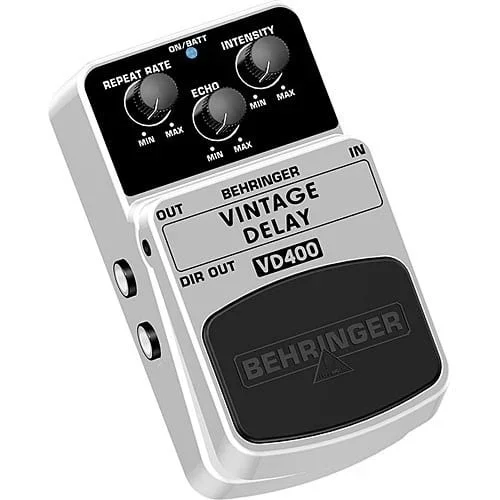
Good choice for beginners Analog delay + slap back echo Plastic case Cheap quality construction
Designed to mimic the classic delay types of the 60’s, this pedal has conquered the pedalboard of countless guitarists across the world.
- Perfect choice for beginners or musicians on a tight budget
- Analog delay and vintage slap-back echo
- Up to 300 ms of delay
- Customize the delay effect with the Intensity, Echo and Repeat Rate dedicated controls
- Separate dirty-out to independently manage the unaffected signal
- As for the negative points, there is a common feature shared between almost the entire Behringer effects pedals: the plastic case. The overall - construction quality is pretty cheap.
This can be a turning point if you are looking for a durable and gig-ready pedal. In that case, a pedal with a metal/aluminum is a must.
Donner Yellow Fall
The Donner Yellow Fall is, in my opinion, the best analog delay pedal you can find at the moment for tight budgets (under $50).
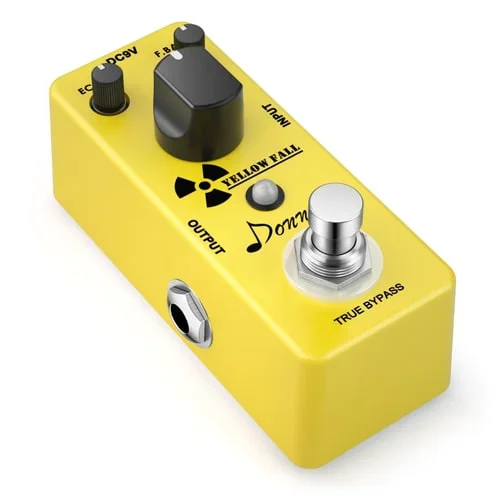
This pedal has propelled itself to the top-selling lists on Amazon by its own merits, for the great combination of sound and build quality and an unbeatable price.
- More than 500 reviews on Amazon, with 4.4 stars
- It does NOT color the sound!
- Aluminum case
- Up to 620ms of delay
- Customize the delay effect with the Echo (mix), Time and Feedback (repetitions) dedicated controls
Although the build quality is lower compared to the Mooer pedals (so is the price), the Donner Yellow Fall produces a really good sound and works pretty well under any circumstance.
As an alternative to the Donner Yellow Fall, you can also check out the Joyo JF-33. Although less popular, it’s also a cheap and durable Analog delay pedal with basic controls and great sound.
Mooer Reecho
The Mooer Reecho is an excellent delay pedal, simple to use and get awesome delay effects.
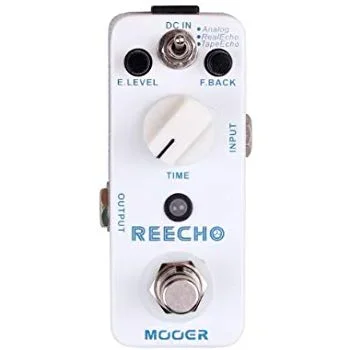
It comes enclosed in a full metal micro case and offers three different but all usable delay types, which with the help of the Time, Mix and Feedback knobs provides you a wide range of experimentation.
The Time knob ranges from 5ms to 780ms.
Although it’s listed as a Digital delay pedal, the Mooer Reecho can simulate an analog delay sound. Here are the details of the different delay types you can get:
- Analog: simulates a warm and smooth echo sound created by classic analog delay equipment
- Real Echo: simulates a natural echo sound in real environment
- Tape Echo: simulates the sweet and spacy echo sound from a vintage tape echo machine
If you want a pedal for any use case (home and gigs), durable, easy to use with lots of customization options and you don’t want to pay for a “professional” delay pedal, then this is clearly your best bet.
Mooer also has the Mooer Ana Echo: an analog delay pedal with a single delay type (analog).
I don’t include it in this list because it doesn’t add any value to the Mooer Reecho, as this pedal already includes an analog delay mode + 2 extra modes… for virtually the same price.
Joyo D-Seed
The Joyo D-Seed is one of the most expensive pedals of the Joyo catalog (if not the most)… and for a good reason: this pedal outperforms all the quality standards of its pedals family!
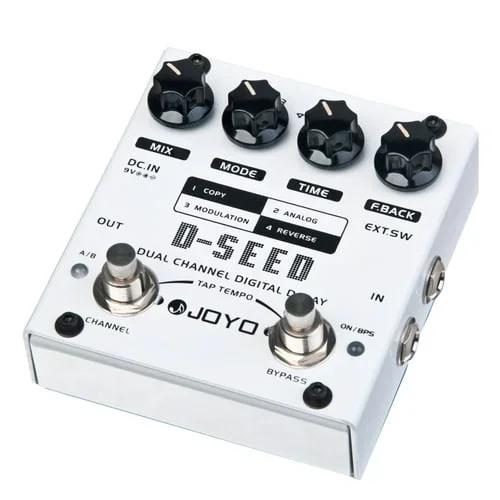
You can use this pedal for a wide range of music styles due to its customization capabilities.
With the Mode control, you can switch between 4 different delay modes: Copy, Analog, Modulation and Reverse.
If you combine them with the three additional knobs to control the Mix, Time and Feedback, you have plenty to play with.
Where does this “Dual Channel” come from? The Channel switch lets you… switch? between two different channels, each one having its own saved delay parameters(presets).
The Time knob ranges from 17ms to 1000ms. This can be extended to up to 6 seconds when using the TAP TEMPO mode, which allows you to set two different delay times. This function is activated by pressing the two footswitches at the same time.
As a negative point, I would say that this pedal is a little confusing to use (in my experience). Fortunately, Thomann has some sort of official user manual.
Also, for 15 extra dollars, you can get the Xvive Memory, which is better in every aspect.
Xvive Memory
The Xvive Memory Analog Delay was designed by Howard Davis, the guitar effects guru behind the wildly successful Electro-Harmonix Memory Man Deluxe, known as one of the best analog delay pedal of all times.
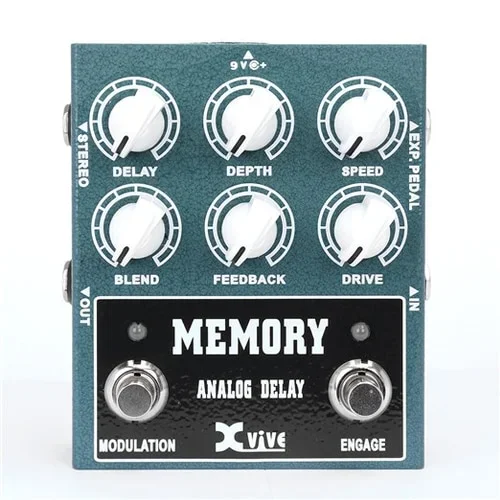
The idea behind the Xvive Memory is simple: to replace the Memory Man and improve it in all ways. And these guys nailed it…
- Up to 600 msec of delay time
- Buffered bypass with a 900K input impedance
- Controls for: delay, depth, speed, blend, feedback, drive gain (creamy overdrive!)
- Provides a clean high-frequency response, even at long delay settings
- Separate stereo output
The flexibility that this pedal provides makes it a must-have on any pedalboard. One of the things I really love about this pedal is the Blend control, which lets you choose from a 100% dry signal to completely wet.
Its small size and affordable price make it even more difficult to resist from buying it.
Top 5 Delay Pedals Over $100
Ibanez ADMINI
With its ultra-compact size, the Ibanez Analog Delay Mini pedal packs true analog delay tone that can fit on even the most cramped pedalboards.
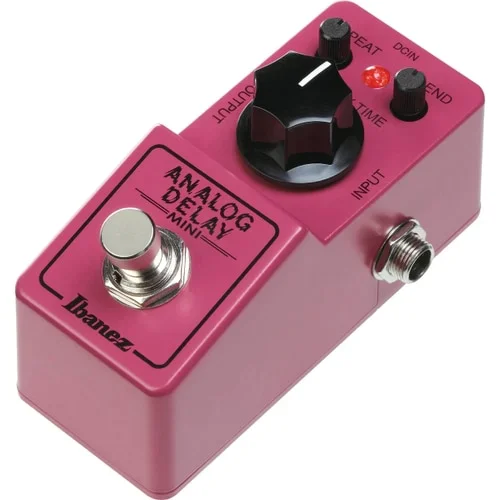
This pedal is a reissue of a classic pedal, the Ibanez AD9, discontinued due to a shortage of its core chip, causing a disproportionate price increase that only pedals collectors would be willing to pay for.
Includes the typical 3-knob layout that allows you dial in everything from short slapbacks to echoes with the 20ms to 600ms delay time range.
The signal path is 100% analog and, although not the best option for a delay effects pedal, it is true bypass. The problem with true bypass is that when you disengage the unit you’re going to lose any lingering repeats.
Some delay pedals offer the ability to turn on a buffered bypass mode, which allows the trails to finish fading out naturally.
Boss DD-3
The Boss DD-3 is without a doubt the first pedal that comes to my mind when someone asks me for a digital delay effects pedal recommendation.
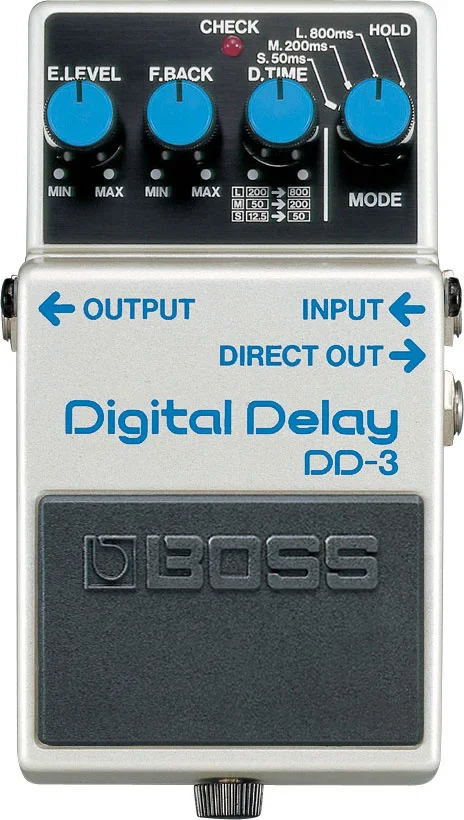
For the last 20 years, this built-like-a-brick stompbox has proved to the world to be a durable and high-quality pedal, earning the title of “Classic Digital Delay” for a lot of musicians.
Exploring The Delay Modes
The DD-3 provides 4 modes (50 ms, 200 ms, 800 ms and Hold) and three knobs to control the parameters (delay time, feedback and effect level).
If you select one of the first three modes, the selected mode will define the Delay Time knob range:
- S 50ms: delay time range from 12.5ms to 50ms
- M 200ms: delay time range from 50ms to 200ms
- L 800ms: delay time range from 200ms to 800ms
Finally, the Hold mode that lets you repeat a delay indefinitely while you play over it.
More DD-3 Features And Limitations
One of the coolest features of this pedal is the Direct Out, which can be used to send the untreated signal to a second amplifier to achieve a true stereo delay effect.
The DD-3 is an excellent digital delay pedal that covers the needs of what most of the guitarists will ever ask for a delay stompbox.
It gives you clear delay tones, easy as that.
Even though, this pedal won’t be enough if you are into the atmospheric textures thing or just looking for some specific delay feature.
For example, the DD-3 doesn’t have tap tempo, so if you need that, check out its big brother: the Boss DD-7
In that case, I’d recommend you to take a look at $150+ delay pedals.
Way Huge Aqua-Puss
Few guitarists are lucky enough to own an original Aqua Puss analog delay pedal. Luckily, Way Huge is offering up a reissue of this coveted model at a fraction of the cost of a vintage used one.
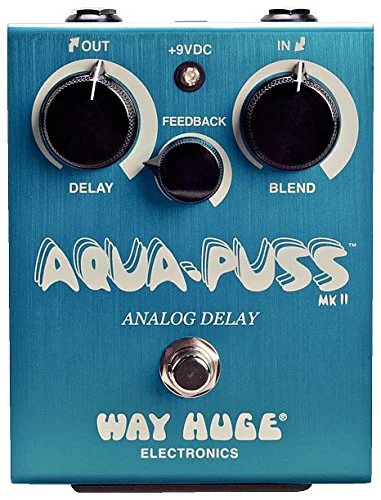
Fun fact: Noel Gallagher has always been a faithful follower of this heavy and well-built pedal.
Vintage Analog Delay. How Does That Sound?
This product is usually described as a “beautiful sounding analog delay pedal”. If you have never heard an analog delay, you probably won’t know what they are talking about.
The Aqua-Puss imparts a classic warm and sweet sound characteristic from country music.
There is a slight noise at highest delay settings, but this is to be considered as a genuine feature, as most of the old vintage delays present the same behavior.
Easy To Use But Short In Features
The handling of the unit is pretty easy. Three knobs for Delay (between 20ms to 300ms), Blend (wet/dry mix ratio) and Feedback (number of repeats) can be found at the top of the pedal.
If you rotate the Delay control back and forth from 7 to 5 o o’clock, the pedal will enter in a self-oscillating state. You can see it in action in this video.
Delay time is limited to 300ms, has no internal trim pots, tap-tempo or anything. Just a straightforward delay with no added sugar.
If you love the Way Huge Aqua-Puss sound but you are looking for more advanced features, there is a supercharged version called Way Huge Supa-Puss, with an extra cost of $100 approximately.
MXR M169 Carbon Copy
Probably the most used Delay pedal, the MXR Carbon Copy has earned its place onto many pedalboards providing a high-quality sound with an extremely wide range of customization possibilities at an affordable price.

Combines the organic and warm tone of vintage analog delays without the associated fragility.
The delay times, while not competitive with digital delays, are far greater compared with what we can find in other analog delay pedals.
(Here is the official manual, in case you want to check some sample settings or pedal specs)
Three Knobs For Absolute Delay Control
In this pedal has the typical delay pedal layout of 3 knobs: Delay (delay time up to 600ms), Mix (dry/wet ratio, also called Blend in other pedals) and Regeneration (number of repeats also known as Feedback).
With the Delay control on its lower value (7 o’clock), it produces classic reminiscent slapback delay tones.
Taking the Regeneration knob to the far right end enables the self-oscillating effect that can be used for creating even more mind-blowing experimental sounds.
Overall, the Carbon Copy has a unique character which makes it more than just a clone or emulation of some classic design.
Using The Modulation Control
The magic continues with this extra control, a tiny button that allows you to enhance the pedal’s repeats adding a new layer of customization.
The modulation button just toggles this functionality. In order to customize its effect, the pedal has two internal trim pots that offer user-adjustable width and rate control.
It’s worth the effort and time opening it up to find your own preferred settings.
Why Is It So Popular?
If you check the best selling delay pedals on Amazon within the 100 to 200 price range, you will see that the most reviewed pedal is the MXR Carbon Copy withmore than 200 positive reviews, only followed by the Boss DD-7, a digital delay pedal with around 100 reviews.
You should wonder why one pedal gets +200 reviews while others of the same price get between 10 and 50.
And this not only happens on Amazon, check any other website like Sweetwater and you’ll see a similar situation.
So, what’s the secret of this pedal?
While the Carbon Copy is an analog delay, the tone is considered to be somewhere in between vintage analog delays and more modern digital delays.
This balance combined with the reliability of a brand like MXR, the affordable price, and the customization possibilities makes this pedal the most attractive option for most of the guitar players.
Dunlop EP103 Echoplex
Based on the vintage 1970s Maestro Echoplex EP-3 (a tape delay “machine”), the Dunlop EP103 Echoplex can produce everything from subtle chorusing and slapback effects to long modulated echoes.
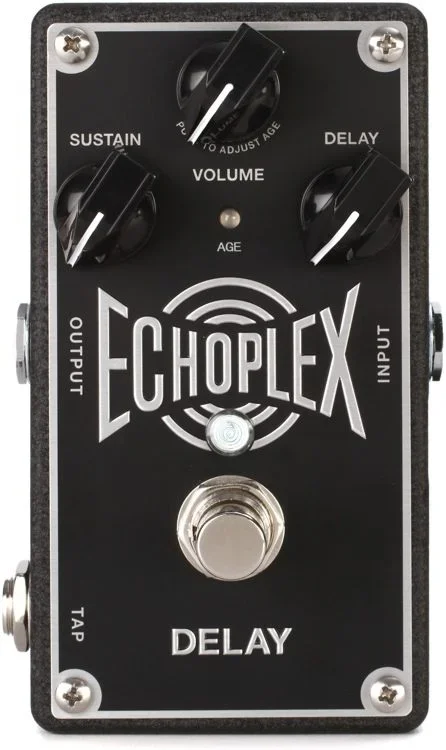
This pedal is used by one of my favorite guitar players: George Lynch! (check this link to see his full setup)
Default Delay Mode
In its default mode, the Echoplex Delay offers a carefully tweaked version of the EP-3, with a dynamic delay range from 4ms all the way to 750ms.
When connected to the MXR Tap Tempo pedal, the delay time stretches to an amazing four-second tape loop.
The Tap Temp thingie is sold separately, which I consider it as a super negative point. You either add the feature or not, but don’t half-add it to force the final user to buy a piece of gear that will hardly use with other pedals.
The default mode offers a gentle equalization and subtle modulation of the original, while the Sustain control (as expected) changes the number of repeats.
What Is That “Age” LED?
Pressing the Volume knob activates the Age mode, and the Volume knob now becomes a virtual age control, adding wear and tear to the delay.
This is translated into a variation in the delay tone from bright and clean to dark and saturated.
Trails, Stereo And Auto Step-Up
By exploring the guts further, you’ll find the option to operate in buffered (trails mode) or true bypass mode, along with a full-wet mode. Read the official manualto learn how to enable the trails bypass.
Both input and output jacks turn into stereo ins and outs via internal switch, which determines the connection type. In order to actually use the stereo setup, you will need to use a TRS splitter cable.
The dry path of the Echoplex is 100% analog, featuring an internal step-up converter which internally increases the operating voltage to 20V, providing a supreme headroom that eliminates clipping that may cause in highly stacked pedal boards.
Plus, the Echoplex Delay is optimized for the Dunlop Echoplex Preamp.
Wrapping Up!
We have reviewed some of the best analog and digital delay pedals, covering a variety of form-factors, delay types, features and sounds.
As a final advice, I would recommend getting a +$50 pedal if you want a durable and gig-ready pedal. But if you want to experiment with new sounds and features or you are just looking for a pedal to use at home, then go for it and try any of the cheaper models!
I leave you with an awesome video from Roland to close this up, where you can learn all the basics of delay pedals. Johnny DeMarco guides you through every knob in the Boss DD-7, which are pretty common in other models, explaining the effect that they have on the tone, as well as the different delay modes you can get from it. Enjoy!